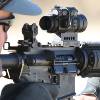Eightball
Member
The inevitable ACOG/AR optic thread, hopefully with a twist.
I've been thinking about ACOGs for a while, and sure, you'll hear a lot of "it's the best thing out there, military uses it, etc etc etc" type things. For someone who is not in the military, or training for the end of the world/CQB scenarios on a regular basis, I don't hear too many "on-hand" tales from these things too often. About all I've heard is that sometimes, in daylight, the reticle becomes too bright and is almost fuzzy--not good for accurate shooting out of an accurate rifle.
Another thing is that I've heard that the element used to light up at night has a half-life of 5 years.
Pretty much, my questions (however coherent they happen to be at 2AM) is are they REALLY all they're cracked up to be, with the whole "illuminated scope, always, no batteries" thing? And, since I've only viewed them inside gun shops--how's the "real-world" light transmission through the glass? And, what happens to the tritium after X amount of time? I'm really curious about that last bit with the elemental half-life, since I've usually only heard stories relating to ACOGs from guys who haven't owned them for that long, and that makes me question if they're really worth the near $1000.
I know this aspect gets done to death, and many people will think "use the search option"--but, I would encourage anyone to search for AR specifics, 1911 specifics, AR OPTIC specifics, and enjoy wading through the thousands of posts on each topic. Plus, it's 2AM.
Anyhow, what's the general consensus on my questions?
I've been thinking about ACOGs for a while, and sure, you'll hear a lot of "it's the best thing out there, military uses it, etc etc etc" type things. For someone who is not in the military, or training for the end of the world/CQB scenarios on a regular basis, I don't hear too many "on-hand" tales from these things too often. About all I've heard is that sometimes, in daylight, the reticle becomes too bright and is almost fuzzy--not good for accurate shooting out of an accurate rifle.
Another thing is that I've heard that the element used to light up at night has a half-life of 5 years.
Pretty much, my questions (however coherent they happen to be at 2AM) is are they REALLY all they're cracked up to be, with the whole "illuminated scope, always, no batteries" thing? And, since I've only viewed them inside gun shops--how's the "real-world" light transmission through the glass? And, what happens to the tritium after X amount of time? I'm really curious about that last bit with the elemental half-life, since I've usually only heard stories relating to ACOGs from guys who haven't owned them for that long, and that makes me question if they're really worth the near $1000.
I know this aspect gets done to death, and many people will think "use the search option"--but, I would encourage anyone to search for AR specifics, 1911 specifics, AR OPTIC specifics, and enjoy wading through the thousands of posts on each topic. Plus, it's 2AM.
Anyhow, what's the general consensus on my questions?




